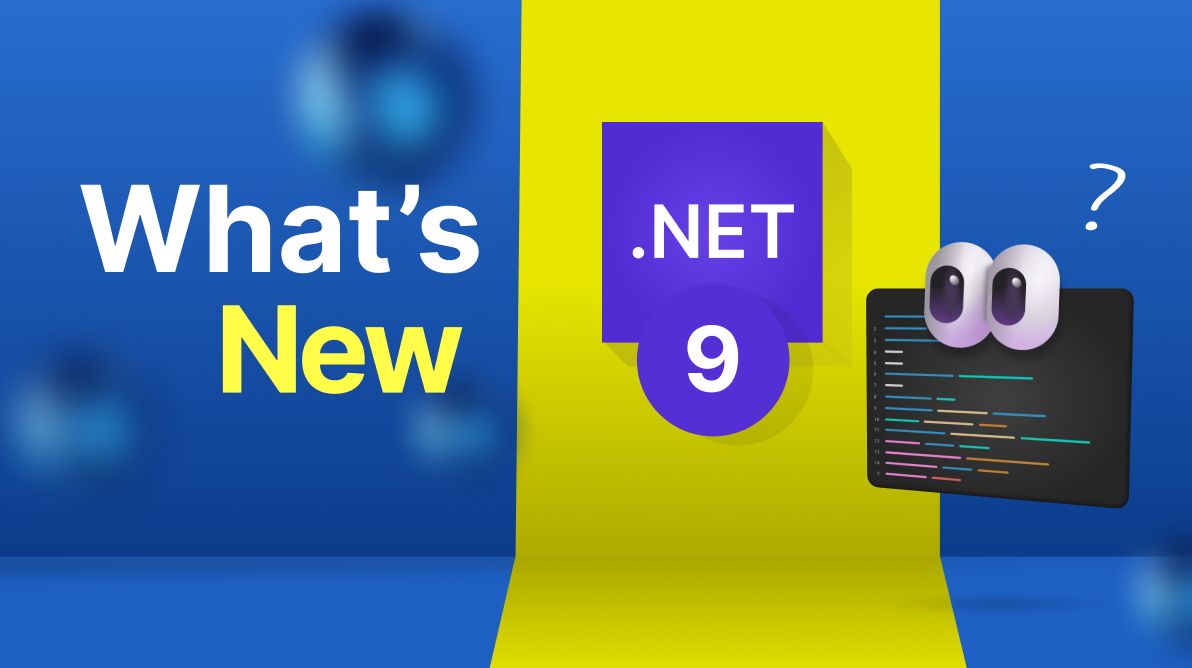TL;DR: .NET 9 introduces significant improvements across the board, with a focus on performance enhancements in the runtime and libraries, simplified development workflows with the SDK, and exciting new features in frameworks like ASP.NET Core, ML.NET, .NET MAUI, and EF Core.
.NET 9 has arrived, bringing a host of new features and improvements that aim to enhance performance, simplify the development process, and expand the capabilities of various frameworks. As developers, we’re constantly seeking ways to improve our workflow and deliver high-performance apps.
In this blog, we’ll explore the key features of .NET 9, focusing on areas like the .NET runtime, .NET libraries, .NET SDK, ML.NET, .NET MAUI, EF Core, and ASP.NET Core, while touching on C# 13 and Windows Presentation Foundation (WPF). Whether you’re building web, desktop, or mobile apps, .NET 9 has something for you.
.NET Runtime: A foundation for performance
At the core of .NET 9 is its improved runtime. Performance enhancements in areas such as Just-In-Time (JIT) compilation, garbage collection (GC), and native interoperability have resulted in faster app execution times and reduced memory overhead.
JIT compilation: The JIT compiler in .NET 9 has been further optimized for faster startup times, leveraging tiered compilation more effectively. This enables your app to start up quickly with lower overhead, while high-impact methods are compiled with full optimizations as they are executed.
C#
public static int SumArray(int[] arr)
{
return arr.Sum();
}This simple code snippet benefits from faster JIT compilation in .NET 9, especially in large-scale apps where performance improvements like these can be more noticeable.
Garbage Collection (GC): The garbage collector in .NET 9 has been optimized for better performance, especially in apps with high memory usage. It now features improvements that minimize latency for large object heap (LOH) allocations, enhancing real-time performance in memory-intensive scenarios.
.NET libraries: Expanding the toolbox
.NET 9 introduces new and enhanced libraries to simplify development. Improvements have been made in areas such as cryptography, file I/O, and JSON serialization.
Cryptography enhancements: The cryptography library now supports hardware-accelerated cryptographic algorithms. This means cryptographic operations such as hashing, and encryption can leverage hardware instructions for better performance.
C#
using System.Security.Cryptography;
var data = Encoding.UTF8.GetBytes("Hello, .NET 9!");
var hash = SHA256.HashData(data);
Console.WriteLine(Convert.ToBase64String(hash));This hashing example demonstrates the usage of the cryptography library, with enhanced performance due to hardware acceleration.
File I/O enhancements: File reading and writing in .NET 9 has been optimized, with better support for asynchronous operations. This is particularly important when handling large files or performing multiple file operations simultaneously.
C#
using (FileStream fs = new FileStream("example.txt", FileMode.Open, FileAccess.Read, FileShare.Read, 4096, true))
{
byte[] buffer = new byte[fs.Length];
await fs.ReadAsync(buffer, 0, buffer.Length);
}.NET SDK: Easier setup and management
The .NET 9 SDK brings several improvements to how developers interact with and manage .NET projects. The SDK now supports unified package management, making it easier to handle multiple package sources and dependencies in larger solutions.
Targeting multiple frameworks: The SDK simplifies multi-targeting by improving support for libraries that target multiple versions of .NET or other platforms, such as Xamarin or Mono.
xml
<PropertyGroup>
<TargetFrameworks>net9.0;netcoreapp3.1</TargetFrameworks>
</PropertyGroup>This multi-targeting setup allows your library to support both .NET 9 and an older version, ensuring backward compatibility while taking advantage of new features.
ML.NET: Bringing machine learning to the masses
ML.NET, the machine learning framework integrated into .NET, has seen several updates in .NET 9. The framework now includes more pre-built models, making it easier for developers to leverage machine learning without needing to write custom algorithms.
New model enhancements: In addition to the performance improvements, ML.NET 9 simplifies integrating models with minimal configuration. This makes it easier to implement predictive analytics and recommendations in your apps.
C#
var mlContext = new MLContext();
var data = mlContext.Data.LoadFromTextFile<ModelInput>("data.csv", separatorChar: ',');
var pipeline = mlContext.Transforms.Categorical.OneHotEncoding("Label")
.Append(mlContext.Transforms.Conversion.MapValueToKey("Label"))
.Append(mlContext.MulticlassClassification.Trainers.LbfgsMaximumEntropy());
var model = pipeline. Fit(data);In this example, ML.NET helps you build a machine learning pipeline with ease, performing tasks such as one-hot encoding and multiclass classification with built-in transformers.
ASP.NET Core: Building the modern web
ASP.NET Core continues to be the flagship web framework for .NET developers, and .NET 9 adds several features to enhance your web development experience.
Blazor server enhancements: Blazor Server has received improvements that reduce latency and increase responsiveness, especially in high-latency environments. This makes Blazor apps more responsive and scalable.
C#
@page "/fetchdata"
@inject HttpClient Http
@if (forecast is null)
{
<p>Loading...</p>
}
else
{
<table class="table">
<thead>
<tr>
<th>Date</th>
<th>Temp (C)</th>
<th>Summary</th>
</tr>
</thead>
<tbody>
@foreach (var f in forecast)
{
<tr>
<td>@f.Date</td>
<td>@f.TemperatureC</td>
<td>@f.Summary</td>
</tr>
}
</tbody>
</table>
}This Blazor Server example demonstrates how you can build fast and responsive web pages with minimal effort in .NET 9.
.NET MAUI: Cross-platform development refined
.NET Multi-platform App UI (.NET MAUI) is evolving, with .NET 9 making it easier than ever to build cross-platform apps that target Windows, macOS, iOS, and Android.
Single project structure: With a single project targeting multiple platforms, you can now manage your resources, code, and platform-specific logic more efficiently.
xml
<MauiProject>
<TargetFrameworks>net9.0-ios;net9.0-android</TargetFrameworks>
</MauiProject>EF Core 9: Streamlined data access
Entity Framework (EF) Core has received substantial updates in .NET 9. Features like performance improvements for bulk operations, better support for complex queries, and enhanced database provider support have been introduced.
C#
using var context = new BloggingContext();
var blogs = await context.Blogs
.Where(b => b.Rating > 3)
.ToListAsync();In this code example, EF Core’s improved performance allows faster querying, especially for larger datasets.
C# 13: More language power
With .NET 9 comes C# 13, introducing enhancements that further simplify the language and make it more powerful. Some new features include better pattern matching, default interfaces, and improved record types.
C#
public record struct Point(int X, int Y);
var point = new Point(3, 4);
Console.WriteLine(point.X); // Output: 3Windows Presentation Foundation (WPF)
.NET 9 also brings updates to WPF improving its integration with the latest .NET runtime features and enhancing performance for desktop apps.
.NET 8 vs .NET 9: Feature comparison
Feature | .NET 8 | .NET 9 | Explanation |
JIT Compilation | Tiered JIT, optimized. | Faster startup, further optimized. | Faster startup times and method-level optimization. |
Garbage Collection | Basic optimizations. | Improved LOH allocation. | Enhanced memory management and reduced latency. |
Cryptography Library | Limited hardware support. | Full hardware acceleration. | Hardware-accelerated cryptography for faster operations. |
Blazor Server | Initial support. | Latency and scalability improvements. | Better handling of high-latency environments. |
.NET MAUI | Early stages. | Improved single-project support. | Easier cross-platform development with a unified structure. |
EF Core | Standard performance. | Bulk operation performance boost. | Faster bulk operations for large datasets. |
Conclusion
Thank you for reading this article! .NET 9 represents significant progress for developers, offering enhanced performance, streamlined tools, and new features that simplify the development process. Whether you’re working on web apps with ASP.NET Core, cross-platform projects with .NET MAUI, or data-intensive apps using EF Core, there is something in .NET 9 for you. Upgrading from .NET 8 to .NET 9 brings tangible improvements that enhance the developer experience and app performance.
Syncfusion provides a wide range of components and frameworks for various platforms, including WinForms, WPF, WinUI, .NET MAUI, ASP.NET (MVC, Core), Xamarin, Flutter, JavaScript, Angular, Blazor, Vue, and React platforms. Use them to boost your app development speed.
Visit our YouTube channel, documentation, GitHub demos, and web demos for more information about our components.
For current customers, the newest version is available for download from the License and Downloads page. If you are not a Syncfusion customer, try our 30-day free trial to see how our components can enhance your projects.
You can contact us via our support forum, support portal, or feedback portal. We are always delighted to help!







